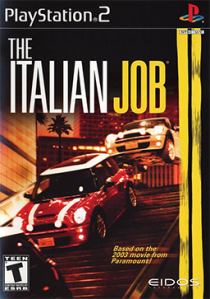Gamestyle Archive intro: Daniel James takes the Italian Job for a spin in June 2003 and fails to find top gear.
A Hollywood blockbuster-remake of a classic Brit-flick is hardly likely to please fans. Similarly, a licensed videogame cash-in (spread thinly over the three main console platforms) is hardly likely to win over any serious gamers either. Loosely following the latter part of the new movie’s plot, The Italian Job sees you take on the role of Charlie Croker and his gang of talented partners-in-thievery, on a mission of revenge and reward to reclaim a stash of stolen gold bars.
Despite the obviously misleading title, the set of The Italian Job is based in a recreation of Los Angeles and Hollywood – not Italy – and certainly consists of more than one ‘job’. Split into fifteen different missions, you take control of various vehicles (not restricted entirely to the infamous Minis) and cruise the streets using a primitive radar to guide you to your target. Variety is sadly lacking however, as most objectives consist of a ‘get-from-A-to-B’ situation, with little scope or reward for deviation. Furthermore, with most missions split into three sub-objectives, the player is forced to perfect them all and complete them in one go, or face a frustrating restart. Whilst preliminary stages are more forgiving, later levels can be a very patience-testing experience, where seemingly unfair and unknown forces – and traffic – work against you to remove your vehicle from its path and into the failure lane.
One particular stage (that will no doubt keep most occupied for several hours) requires you to run a perfect race through an underground subway system against rival Minis, with only your memory of the path ahead and quick reflexes to save you from the perilously placed pipes and protruding walls. Practice, however, does make perfect. But one must ask themselves if they really do want to be retrying the same section over and over again, for the simple pleasure of seeing the next one. And therein lies another problem. The game’s structure is so linearly laid out before you that no missions can be overtaken; there are no detours on this drive. But thankfully, a sleek and fast user interface sees navigating your chosen level become a breeze, and instant reloads prevent any impatient finger-tapping. Visually, The Italian Job is good and solid, though nothing that will trouble the conscience of any Polyphony Digital staff. What the game lacks in detail it makes up for with impressive framerates and sharp, clear picture quality. This is even more noticeable after the mid-mission fly-by cinematics that purposely run at a reduced 25 frames per second (or thereabouts) with a grainy movie-style filter overlay, to replicate that cinematic feel.
When the action begins, it all appears to positively fly by. It’s only the slight aliasing, V-synching, and very occasional slowdown that ruins an otherwise solid-looking environment. But whilst solid, The Italian Job’s locales seem nothing but dead, due to the total lack of pedestrian activity. Not a person in sight, and this doesn’t stop at just the environments; even the cut-scenes are devoid of hired actor activity, with only stills of the vehicles and the voice of Charlie as the narrator to give the impression of any humanity at all. Why this apparent distancing from human contact wends its way into The Italian Job, Gamestyle can only speculate. But the stars of the show are definitely those Minis, and they certainly do get the chance to flex their acting muscles. Despite their size, the cars feel positively weighty, with plenty of wheel friction making for some very satisfying handbrake turns and generally decent handling.
Climax Studios is no newcomer to vehicle reproduction (two-wheeled or otherwise), and The Italian Job – whilst rough around the edges – is no exception. It seems a glaring oversight then, that only the (right) analogue stick offers incremental acceleration control, when the touch-sensitive face buttons could have done an improved job of replicating the same feature. Gamestyle brings this up because of the ‘dead space’ around the Dual Shock’s movement range, the delayed response of the car to throttle increments, and the occasional necessity of slower movement at key stages of the game (particularly the Stunt Course mode). But a substitute ‘tapping’ method proves adequate for the most part. The Stunt Course mode (abovementioned) strangely seems to offer the most addictive part of the overall package, saving the game from a pit of mediocrity.
Even Reflections’ dedicated ‘Stuntman’ could learn one or two things from TIJ’s approach. No commands screamed at you, no frustrating checkpoints, just a clearly marked route from A to B (again!) via all varieties of ramps and pipes – indoor and out – that really push what those versatile Minis can do. Certainly not easy, but any perfectionist will revel in the chance to boost their score and grade. The Stunt mode is actually criminally under-exploited with only a handful of courses to try, but with every level of the story mode featuring a grading system as well, one can easily turn familiar areas of the city into practiced and perfected courses – not too unlike the real thing then. The Italian Job loosely follows the plot of the movie, whilst filling in arbitrary plot points with samey mission objectives and a sloppy reward structure. Its few missions aren’t likely to last a long time, notwithstanding the rewards (unlockable vehicles) for higher grades upon replays. The competently tacked-on Racing mode features a decent enough one or two-player game, but lacks the depth of dedicated titles. Fans of the new movie will probably appreciate it more, however Gamestyle has to ask; was it all really necessary?
Gamestyle Score: 5/10
